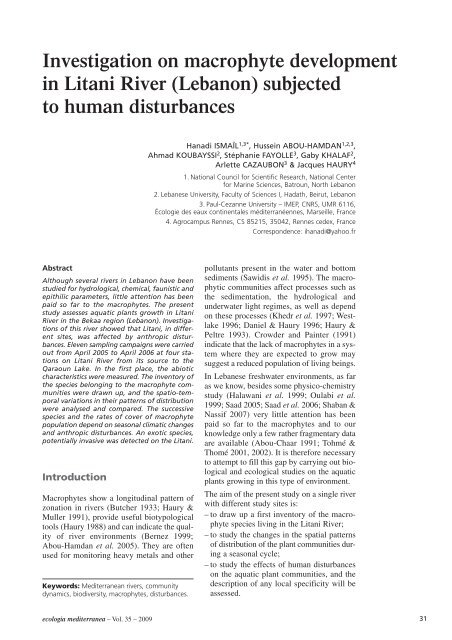Vol. 35 – 2009 - Ecologia Mediterranea - Université d'Avignon et des ...
Vol. 35 – 2009 - Ecologia Mediterranea - Université d'Avignon et des ...
Vol. 35 – 2009 - Ecologia Mediterranea - Université d'Avignon et des ...
Create successful ePaper yourself
Turn your PDF publications into a flip-book with our unique Google optimized e-Paper software.
Investigation on macrophyte development<br />
in Litani River (Lebanon) subjected<br />
to human disturbances<br />
Abstract<br />
Although several rivers in Lebanon have been<br />
studied for hydrological, chemical, faunistic and<br />
epithilic param<strong>et</strong>ers, little attention has been<br />
paid so far to the macrophytes. The present<br />
study assesses aquatic plants growth in Litani<br />
River in the Bekaa region (Lebanon). Investigations<br />
of this river showed that Litani, in different<br />
sites, was affected by anthropic disturbances.<br />
Eleven sampling campaigns were carried<br />
out from April 2005 to April 2006 at four stations<br />
on Litani River from its source to the<br />
Qaraoun Lake. In the first place, the abiotic<br />
characteristics were measured. The inventory of<br />
the species belonging to the macrophyte communities<br />
were drawn up, and the spatio-temporal<br />
variations in their patterns of distribution<br />
were analysed and compared. The successive<br />
species and the rates of cover of macrophyte<br />
population depend on seasonal climatic changes<br />
and anthropic disturbances. An exotic species,<br />
potentially invasive was d<strong>et</strong>ected on the Litani.<br />
Introduction<br />
Macrophytes show a longitudinal pattern of<br />
zonation in rivers (Butcher 1933; Haury &<br />
Muller 1991), provide useful biotypological<br />
tools (Haury 1988) and can indicate the quality<br />
of river environments (Bernez 1999;<br />
Abou-Hamdan <strong>et</strong> al. 2005). They are often<br />
used for monitoring heavy m<strong>et</strong>als and other<br />
Keywords: <strong>Mediterranea</strong>n rivers, community<br />
dynamics, biodiversity, macrophytes, disturbances.<br />
ecologia mediterranea <strong>–</strong> <strong>Vol</strong>. <strong>35</strong> <strong>–</strong> <strong>2009</strong><br />
Hanadi ISMAÏL 1,3* , Hussein ABOU-HAMDAN 1,2,3 ,<br />
Ahmad KOUBAYSSI 2 , Stéphanie FAYOLLE 3 , Gaby KHALAF 2 ,<br />
Arl<strong>et</strong>te CAZAUBON 3 & Jacques HAURY 4<br />
1. National Council for Scientific Research, National Center<br />
for Marine Sciences, Batroun, North Lebanon<br />
2. Lebanese University, Faculty of Sciences I, Hadath, Beirut, Lebanon<br />
3. Paul-Cezanne University <strong>–</strong> IMEP, CNRS, UMR 6116,<br />
Écologie <strong>des</strong> eaux continentales méditerranéennes, Marseille, France<br />
4. Agrocampus Rennes, CS 85215, <strong>35</strong>042, Rennes cedex, France<br />
Correspondence: ihanadi@yahoo.fr<br />
pollutants present in the water and bottom<br />
sediments (Sawidis <strong>et</strong> al. 1995). The macrophytic<br />
communities affect processes such as<br />
the sedimentation, the hydrological and<br />
underwater light regimes, as well as depend<br />
on these processes (Khedr <strong>et</strong> al. 1997; Westlake<br />
1996; Daniel & Haury 1996; Haury &<br />
Peltre 1993). Crowder and Painter (1991)<br />
indicate that the lack of macrophytes in a system<br />
where they are expected to grow may<br />
suggest a reduced population of living beings.<br />
In Lebanese freshwater environments, as far<br />
as we know, besi<strong>des</strong> some physico-chemistry<br />
study (Halawani <strong>et</strong> al. 1999; Oulabi <strong>et</strong> al.<br />
1999; Saad 2005; Saad <strong>et</strong> al. 2006; Shaban &<br />
Nassif 2007) very little attention has been<br />
paid so far to the macrophytes and to our<br />
knowledge only a few rather fragmentary data<br />
are available (Abou-Chaar 1991; Tohmé &<br />
Thomé 2001, 2002). It is therefore necessary<br />
to attempt to fill this gap by carrying out biological<br />
and ecological studies on the aquatic<br />
plants growing in this type of environment.<br />
The aim of the present study on a single river<br />
with different study sites is:<br />
<strong>–</strong> to draw up a first inventory of the macrophyte<br />
species living in the Litani River;<br />
<strong>–</strong> to study the changes in the spatial patterns<br />
of distribution of the plant communities during<br />
a seasonal cycle;<br />
<strong>–</strong> to study the effects of human disturbances<br />
on the aquatic plant communities, and the<br />
<strong>des</strong>cription of any local specificity will be<br />
assessed.<br />
31
















